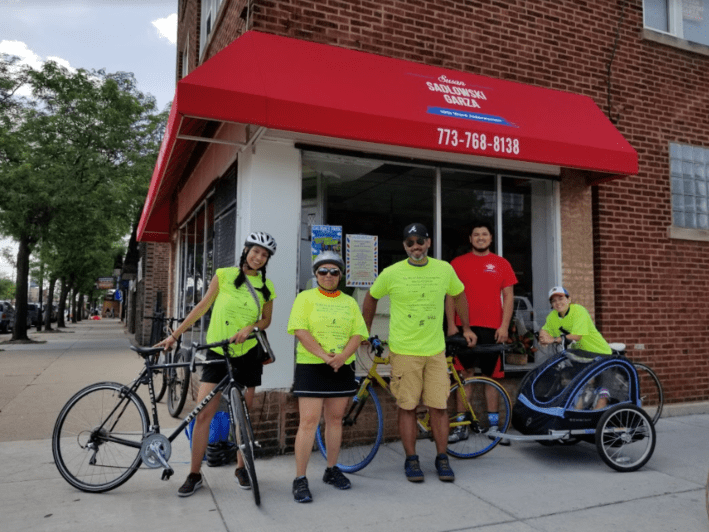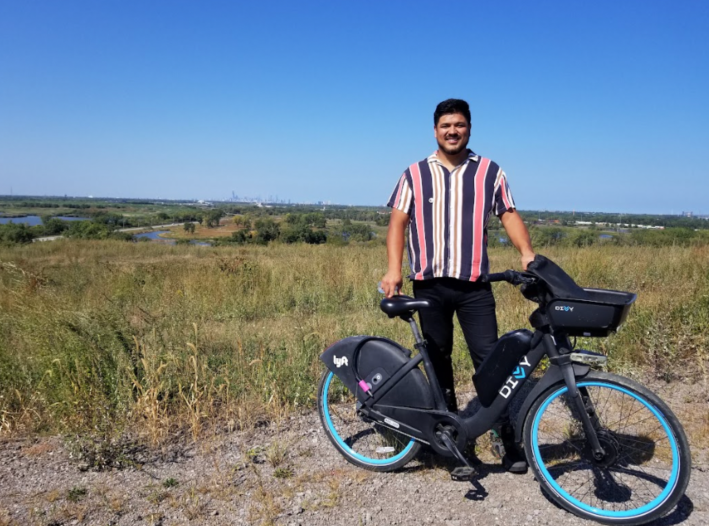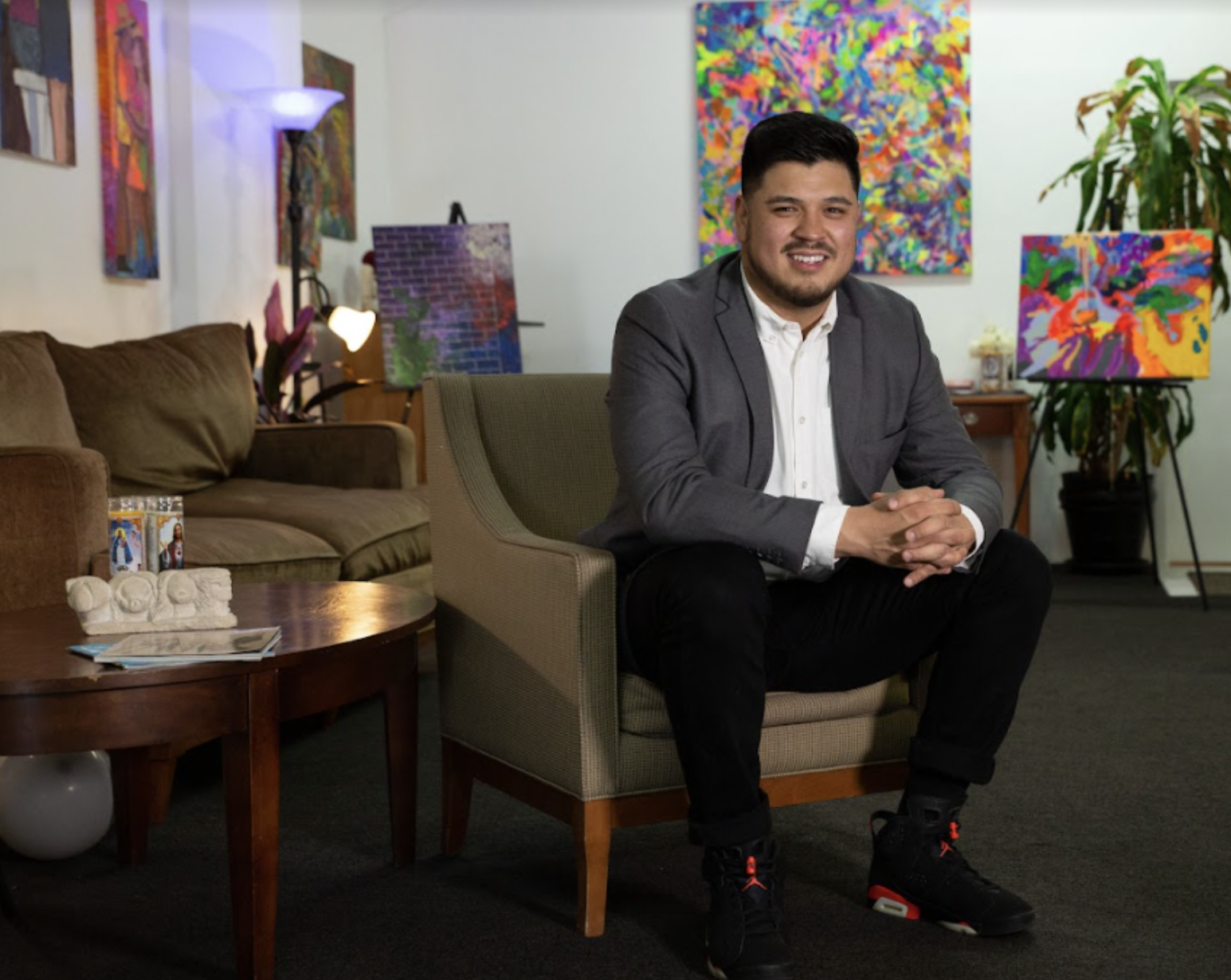Para leer este artículo en español, haga clic aquí.
National Hispanic Heritage Month began on September 15th. To celebrate Latine voices in transportation, I am introducing a recurring segment to highlight Latine urban planners and transportation professionals in Chicago. As of 2021, Latine people make up 18 percent of the U.S. population, and nearly 30 percent of Chicago’s population, but those designing our cities and towns and deciding how they operate don’t always represent our diverse communities. In order to elevate the voices and work of these Chicago professionals, I will interview people who are bettering our city and bringing diverse perspectives to transportation issues.
I interviewed Ismael Cuevas, government affairs manager at Amtrak and previous 10th Ward chief of staff and director of external affairs. He also sits on the board of directors for Friends of Big Marsh, is a 2021 NACTO Transportation Justice Fellow, and is passionate for increasing alternative modes of transportation and decreasing car-dependency in the city and beyond.
Ruth Rosas: You didn’t have a straightforward path into transportation. What did you study in school?
Ismael Cuevas: I got my bachelor’s in Political Science and Sociology from the University of Wisconsin-Madison and I got my master’s in Mexican American and Latino/a Studies from the University of Texas at Austin.
RR: How did you get into the transportation field?
IC: After I received my bachelor’s, I came back to Chicago and was working on immigration and education issues in Little Village. When I started working for the 10th Ward Office in 2015, I realized there were already many great leaders in Chicago working on immigration policy and I felt that my skills could be used in other areas to impact the working class and Latino folks. So I got involved in transportation when we started the Participatory Budget Project at the 10th Ward Office.
RR: Could you tell us what neighborhoods fall in the 10th Ward and explain what the Participatory Budget is?
IC:The 10th Ward is made up of The Bush, Hegewisch, South Deering, East Side, Slag Valley, South Chicago, and Jeffrey Manor. The Participatory Budget allows residents to vote how the alderperson is going to spend the [$1.3] million dollars allocated for infrastructure improvements in the ward. It’s not enough for train extension projects, but you can work on other types of projects that improve transportation access.
In the Participatory Budget Project, I was already the chief of staff in the 10th Ward Office and I was working with residents who were proposing infrastructure projects. The projects ranged from new sidewalks to lighting in the parks, to playground equipment, bike lanes, and so on.
I started to see the disparities of accessibility to transportation in the Far Southeast Side compared to other parts of the city. The Southe East is like a transportation desert. Not just because of lack of access to CTA or Metra but also in alternative modes of transportation. Bike lanes, Divvy bikes, hiking trails, etc. were non-existent in the neighborhood.
The far southeast side is over 60 percent Latino and over 18 percent Black, which means it is a majority-POC area. I started to see how neighborhoods that were mostly made up of people of color severely lacked transportation options. So I started to see how I could bring better transportation to the far southeast side neighborhoods.

RR: What kind of projects did you work on during your time in the 10th Ward?
IC: When I started, I requested a map from the Chicago Department of Transportation of bikeways in the ward and there were essentially three: 100th Street bike lane; the Burnham Greenway trail, which is a multi-use trail that runs north and south through the ward; and the end of the Lakefront Trail, which was extended to 92nd Street and Ewing Avenue, past Steelworkers Park [the bike lanes along South Lake Shore Drive/U.S. Highway 41]. The interesting part of the 10th Ward is that there are multiple natural and man-made boundaries, these include the Calumet River, Lake Michigan, the state of Indiana, the municipality of Burnham, Illinois, multiple railroad crossings, the Skyway, and multiple drawbridges. Looking at the CDOT maps, I realized that people couldn’t easily or safely walk or bike across the ward.
For example, if you wanted to walk or bike from the East Side to Hegewisch, there was no connectivity in our transportation system to get you there. So I started working with Ald.Susan Sadlowski Garza to see what opportunities there were to expand transportation. I began working on expanding the bike network with the Chicago Department of Transportation. I wanted to make the 10th Ward the most bike friendly area in the South Side of Chicago. So that became my goal.
RR: What are some of the accomplishments of your work?
IC: The alderwoman and our team worked closely with CDOT over my seven years in the 10th Ward to construct several miles of bike lanes. Having Ewing Avenue and 112th Street get bike lanes were a huge accomplishment. Ewing Ave is one of the main North/South throughways and 112th is a major east-west throughway in the ward. Commercial Avenue is also slated to get buffered bike lanes. For me, it was really important that these neighborhoods have options beyond car transportation. Especially because many don’t have reliable car transportation, it was important to provide the residents of the ward a safe way to get through our neighborhoods.
Also getting Divvy stations in the ward was huge, as we didn’t have Divvy until 2020. The closest station we had was by the South Shore Cultural Center. After a few years of advocacy, we finally got a chance to tell CDOT where the community wanted stations. Although we didn’t get all of the stations we wanted, I know that we had a chance to tell Divvy where we wanted these stations to be placed. There’s still a lot of improvement, but now there are Divvy bikes and scooters in the area.
A lot of this was multi-agency work because the 10th ward is at the edge of the city and there are a lot of county and state agencies that had to work together on these projects.
RR: Since you left the 10th Ward, what have you been working on?
IC: Currently, as a government affairs manager for Amtrak, I work with cities and state legislatures in the Greater Midwest area, which includes 15 states around the Great Lakes and their neighboring states. I’m working on access to passenger rail with the Amtrak Connects Us Plan, which is looking to increase rail service to new routes that previously didn’t have access. The goal is to connect areas of population growth with cities on the Amtrak network. What I’m most excited about is working with states on increasing passenger rail in the future. I’m also advocating for people to bring their bicycles on trains and working with municipalities on creative ways of using their train depots as part of a larger multi-modal transportation network.
I think the United States desperately needs more passenger rail and Amtrak has already demonstrated it can provide it as it has done in the northeast portion of the U.S.
RR: Does Amtrak have high-speed rail plans?
IC: It does, and many of these plans are in partnership with the states. For example, Amtrak trains in Michigan now go up to 110 mph on routes across central Michigan. In Illinois, most of the route between Chicago and St. Louis travels at speeds up to 90 mph and soon it will also be a 110mph route. Most of our competition is people driving at conventional speeds of up to 70 mph. Of course, 90 mph and 110 mph is faster than you can legally drive in these states. Amtrak’s Acela in the Northeast Corridor currently reaches speeds up to 150 mph.
RR: How does identity impact your work?
IC: I was born in Zacatecas, Mexico and came here as a toddler when my parents immigrated here. I grew up in a predominantly Mexican immigrant community. I saw how much our community relies on cars. I grew up in the Scottsdale neighborhood near 79th Street and Pulaski Road, which is a transportation desert. We only had the option of two buses and no train, unless you walked 30 minutes to a Metra Station. I had to commute 90 minutes to Whitney Young High School on the Near West Side. This impacted the way I looked at transportation. I knew that my Black and brown classmates had the longest commutes and the most amount of transfers to get to school. So now in my work, I want to remedy that to ensure that people have better and safer commutes, whether it’s biking, walking, scooter, train, bus, etc.
Now that I have the opportunity to travel across the Midwest, I see how suburban and rural communities travel and how they severely lack public transportation. I realize that while there are many areas of improvement, we have it better here in Chicago. I want to ensure people across the country have connectivity not just through cars.

RR: What are some of your current passion projects?
IC: I left the Chicago City Council’s Committee on Workforce Development in the spring of 2022. But I’m still connected to the work down in the far southeast side. I’m a current board member for Friends of Big Marsh. My aim is to get people from all over the city and beyond Chicago to explore Big Marsh Park. Big Marsh was an abandoned industrial lot with almost 300 acres. To see the vacant lot transform into a blossoming ecological and wildlife habitat that also has bike amenities and it is the South Side is incredible. I want to be the person that gets Latinos from all over to get to explore the beauty of Big Marsh.
RR: Do you have anything else you want to share with us?
IC: The municipal elections are coming up. I think it’s really important for local legislators that have direct control of the city’s infrastructure to prioritize biking, walking, and micromobility infrastructure in their neighborhoods. With the rise of pedestrian and cycling deaths, I think it’s important for legislators to tackle these issues and as Chicagoans we should pay attention to local leaders that are envisioning a more walkable, bikeable, transit-oriented city that is less reliant on cars.





